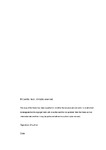Reanimating the Wound: Dermatilliomanic Practice and the First World War
| dc.contributor.supervisor | Cook, Chris | |
| dc.contributor.author | Nock, Camilla | |
| dc.contributor.other | Faculty of Arts, Humanities and Business | en_US |
| dc.date.accessioned | 2016-02-18T11:49:24Z | |
| dc.date.available | 2016-02-18T11:49:24Z | |
| dc.date.issued | 2015 | |
| dc.identifier | 10162826 | en_US |
| dc.identifier.uri | http://hdl.handle.net/10026.1/4342 | |
| dc.description | Theory in conjunction with a painting practice. | en_US |
| dc.description.abstract |
This research project uses an exploratory painting practice to examine a melancholic shadow cast by the First World War. The mode of inquiry is predicated upon the persistence of the past in the present, and upon a personal need to purge a persisting familial grief. To inform this stance there is systematic engagement with cathartic and redemptive artworks of the twentieth century, and with the poetry of the First World War. Developments of process and emotional register are specifically prompted by the writings of William Morris, Edmund Blunden, and Ivor Gurney, and reflections on practice are sub-divided accordingly. Wilfred Owen’s ‘internal reciprocity of tears’, whereby an act of expression traces memory and mourning, remains a central theme throughout. An initial site-based interrogation into desecrated landscapes, using sketchbooks and notebooks, develops into painterly strategies of defacement, compulsive excoriation (the ‘dermatillomania’ of the title) and eventually the deliberate deformation of the picture plane itself. A deep emotional immersion in accounts of the war is sought in order to to establish mindscapes of trauma, to which the radical actions of painting respond. Constant self-reflection is used to consider new areas of research and idiosyncrasies of process as they arise through the practice. The completed body of work explores a trans-generational connection to a legacy of embodied grief, in which the desire to counter the risk of forgetting is mediated through the obligation of the artist to express empathy. The methodology thereby confronts the paradox of catharsis through active mourning in the face of an unresolvable continuation of grief, and tests how narratives of loss may be repositioned and reconfigured in retrieval through the practice of painting. | en_US |
| dc.language.iso | en | en_US |
| dc.publisher | Plymouth University | en_US |
| dc.subject | Dermatilliomanic Practice and the First World War | en_US |
| dc.title | Reanimating the Wound: Dermatilliomanic Practice and the First World War | en_US |
| dc.type | Thesis | |
| plymouth.version | Full version | en_US |
| dc.identifier.doi | http://dx.doi.org/10.24382/4794 |
Files in this item
This item appears in the following Collection(s)
-
01 Research Theses Main Collection
Research Theses Main


